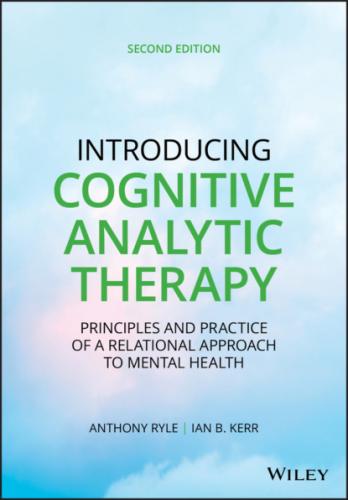Introducing Cognitive Analytic Therapy. Anthony Ryle
a stereotypical BPD‐type diagram. (c) illustrates likely dissociated Self states and (d) introduces a description of typical staff reactions around such patients and illustrates a rudimentary “contextual reformulation” (see Chapter 11).
About the Authors
Anthony Ryle qualified in medicine in 1949 and worked successively as a founding member of an inner city group practice, in Kentish Town, London, as Director of Sussex University Health Service and as a Consultant Psychotherapist at St. Thomas's Hospital, London. After retiring from the NHS he worked part‐time in teaching and research at Guy's Hospital. While in general practice he carried out epidemiological studies of the patients under his care and the experience of demonstrating the high prevalence and family associations of psychological distress influenced his subsequent interest in the development of forms of psychological treatment which could realistically be provided in the NHS. Studies of the process and outcome of psychotherapy followed, and from these grew the elaboration of an integrated psychotherapy theory and the development of the time‐limited model of treatment which became cognitive analytic therapy. He died in September 2016.
Ian B. Kerr graduated in medicine from the University of Edinburgh. After several junior hospital posts he worked for many years in cancer research. He subsequently completed dual training in psychiatry and psychotherapy at Guy's, Maudsley, St. George's, and Henderson Hospitals in London, and with the British Association of Psychotherapists. He worked for several years as Consultant Psychiatrist and Psychotherapist and Honorary Senior Lecturer in Sheffield, UK, and then in NHS Lanarkshire, Scotland, UK. He has been involved in teaching and researching CAT in many settings in the UK and internationally.
Preface to the Second Edition
This revised edition is being offered given an evident need to update, expand, and clarify aspects of the first edition which appeared now almost two decades ago, and given a keen wish by Tony Ryle to do this. Our aim was to offer a summary but comprehensive overview of the current evolved Cognitive Analytic Therapy (CAT) model, its background and comparative context, and of its range of applications, that would be informative and helpful to those new to the model, to trainees and even established practitioners. Very sadly however, as many readers will be aware, not long after being commissioned to do this Tony, who was the senior author and progenitor of the cognitive analytic therapy model, developed a serious illness from which he ultimately succumbed in 2016. Summaries of his remarkable creative personality, his career and contributions to the field of psychotherapy and mental health more broadly have been published in various obituaries which are available on the internet and in a special issue published in 2018 of Reformulation the newsmagazine of the Association for Cognitive Analytic Therapy (ACAT) in the UK, also available on‐line.
One of the critical tests of the achievement of any remarkable, creative, and charismatic character, which Tony certainly was, is the way in which their achievement and any model they may have created survives and prospers subsequent to their death. In this I am very clear, as are many others, that the current CAT model described in some detail in this volume is doing just that and that, given its principles and underpinnings, it should continue to play a major creative and contributory role in the future to human mental health and well‐being in various ways. That this might occur was one of his principal passions and aims. Having said that, like many of us he was recurrently saddened and frustrated by the evident socio‐political direction of the world at large. I am sure his enthusiasm to update and publish this volume despite his illness also related to a hope that the model might in some small way contribute to ameliorating and improving this situation. Certainly, the evolved CAT model seemed to us also to address a global epidemic, including and especially in more “developed” countries, of so‐called mental disorders in a much more radical, thorough‐going, and humane manner than currently dominant, more individualistic and mechanistic paradigms. As such we were sure that if human sense, compassion, and evidence prevail (about which sadly neither author was very confident) CAT will ultimately be able to offer a great deal, including in ways far beyond its use as a model of individual therapy, important as that is, into more clearly systemic and socio‐political domains. These issues and these potential applications are discussed further in the book.
However, Tony’s death left the final task of articulating and presenting many of these revisions to myself. These have however all been based on our extended discussions—some quite animated!—and also on our deep, essential agreement about the core of the model and what sorts of revisions needed to be undertaken. These have been also based on initial drafts that we both did
